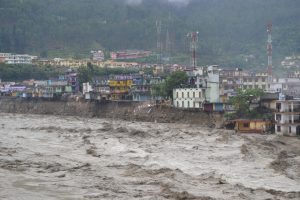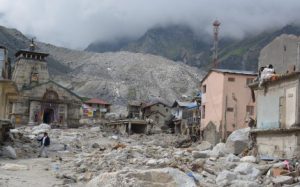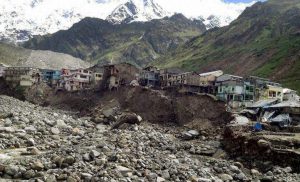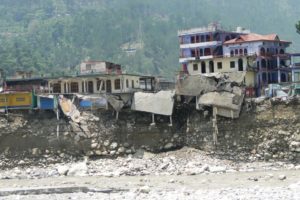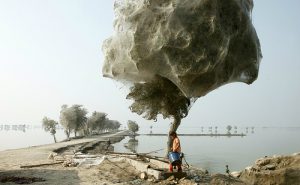Salma Rehman of The Third Pole was caught up in the mayhem surrounding the flash floods and landslides that have killed nearly 1,000 people in Uttarakhand in the Indian Himalayas
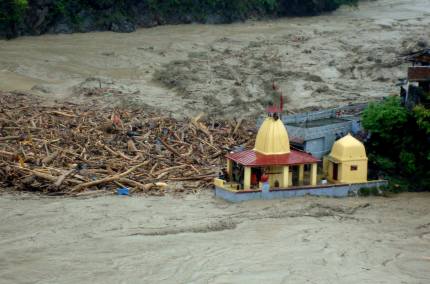
I did not see the flash floods that swept everything down the Himalayas in Uttarakhand on June 16 and 17, but just a few days later, I was stuck in the mayhem that spread across the mountains. What remains uppermost in my mind is the helplessness of humans when faced by the fury of nature.
Having been brought up in Uttarakhand, where my parents live, I was all set to take refuge at home from Delhi’s soaring temperatures. I had made plans with my friends and was eagerly waiting to join swimming classes.
But when I arrived in Dehradun on the morning of June 18, everything was topsy turvy. The whole state plunged into mourning over the nightmare at Kedarnath. We had no idea how many people had been killed by the flash floods, but we knew the number had to be in hundreds.
Then the tragedy became personal. We heard that one of my cousins was in Gaucher, nearly 136 kilometres down from Badrinath. He was quite ill, but he was stuck because the road down to the Indian plains was blocked by the multitude of pilgrims pouring down from Badrinath and Govind Ghat where the floods had played havoc.
Fortunately one of my father’s friends (Shailly Uncle) was also stuck there and was looking after my cousin. My father decided to drive the 200-odd kilometres to Gaucher to bring my cousin home. Despite my mother’s pleadings, I managed to persuade my father to let me go with him. We left around 6 a.m. on June 20.
Our first encounter with the mayhem came soon, as we reached Rishikesh. We saw the Ganga swollen and beating against the banks in a way I have never seen before, though I have lived most of my life near the river. The Shiva idol which used to stick boldly out of the water near Rishikesh was now completely submerged.
We were still determined to reach Gaucher. The first hurdle came at Devprayag which is 86 kilometres before Gaucher. A seemingly endless queue of vehicles jammed the two-lane road which was already in an unreliable condition due to the rains. We spent around seven hours in Devprayag as the traffic was finally cleared by the officials of Public Works Department (PWD).
People in Devprayag told us how the Alaknanda and Bhagirathi rivers – which join up to form the Ganga – smashed into some of the low-lying areas of the town and swept away pieces of land that otherwise remain unaffected even during a heavy monsoon.
I had a big scare during the seven-hour wait. I saw a car parked close to the overflowing river being swept away by the gigantic waves. The vehicle struggled through the rapids before disappearing.
As we made our way to Gaucher we had to face similar traffic hold-ups and our vehicle did no better than a crawl. The road surface was mostly washed away and there was constant fear of more landslides.
We reached Kalyasaur – around 42 kilometres from Gaucher – almost at midnight. Here the traffic was totally stuck. We waited and waited till dawn. Vehicles started to crawl again around 5 a.m. We finally reached Gaucher around 4 p.m. on June 21, having taken 34 hours to cover the 200-odd km. In other times, the journey would have taken around three hours.
As we reached the town we saw thousands of people stranded by the floods. Most were pilgrims returning from Badrinath and Hem Kund Sahib. One pilgrim told us that the Govind Ghat bridge which was swept away by the floods resulted in huge destruction as a large parking area got affected.
He mentioned that around 65 vehicles including motorbikes and cars were floating like paper boats in the river. He also mentioned how difficult was it for them to make their way to Joshimath and then to Gaucher.
As we reached Shailly Uncle’s home we found that my cousin needed immediate medical attention. So we started back for Dehradun around 6 a.m. on June 22, but soon realised that the roads were still totally blocked. The only people getting through were motorcyclists. Four-wheelers were not being allowed as there had been more landslides on the road. There was no electricity in the area; the mobile towers were not working, so there was no way to make a phone call either.
We returned to Shailly Uncle’s home and waited for the traffic to clear. Meanwhile we heard about the rising death toll in the Kedarnath tragedy and also the scary predictions from the meteorological department that it might rain heavily again.
Amidst all the chaos I came down with high fever. I was not supposed to get out of bed. Still, I sneaked out many times to watch the desperate struggle of people to get out of town. We stayed in Gaucher for two more days as officials of the Indo-Tibetan Border Police and PWD helped clear the roads and restore traffic flow.
During this time I saw people crying, begging for help and starving. They were going frantic with rage against the government. They were complaining of the inefficiencies and discrepancies that the government has shown in handling the situation.
There was a ceaseless flow of pilgrims from Badrinath and Govind Ghat. Day by day people were walking out of the heaven that had turned into a hell for them.
We started again from Gaucher around 2 p.m. on June 24. The roads were still jammed, and we finally reached Dehradun at 2.30 a.m. on June 25. My cousin is still unwell. I have not got rid of my fever either.
Salma Rehman is an intern at The Third Pole.
Crisis map and Person Finder launched for India flooding
Google has launched a new crisis map and Person Finder for the floods in North India. The crisis map shows relief camps, road closures and more. New information will be added to the map as the team collects it.
